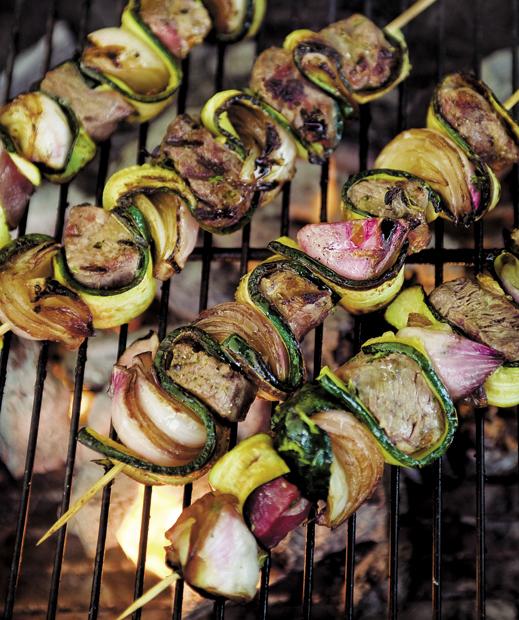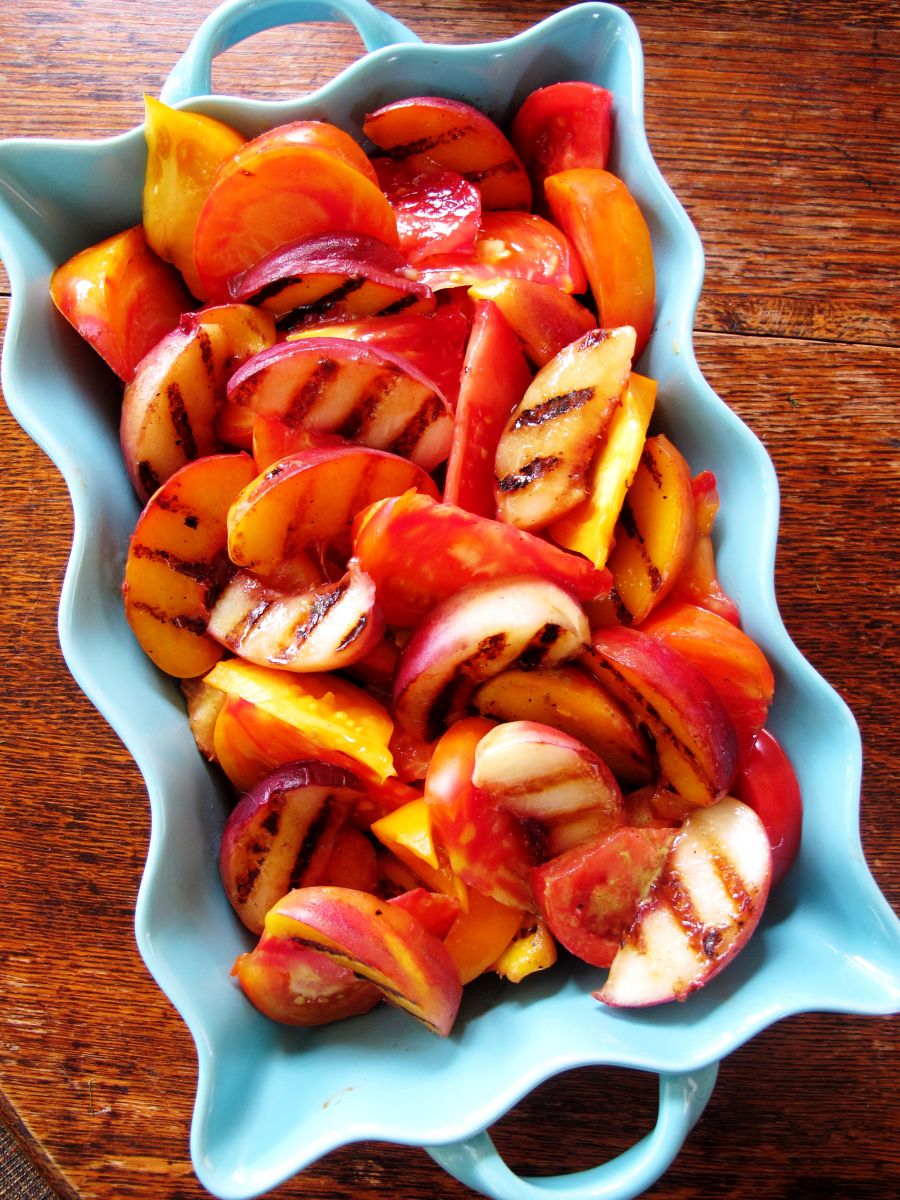
When I was growing up, barbecues were something that occurred rarely and usually on a special occasion. They were not an every weekend occurrence. They were neither practical in rainy London, nor easy to produce as few people had a trusty Weber (or its equivalent) tucked away in their homes. In fact I can safely say that we never cooked a barbecue in London in all the years that I lived there.
You might find it odd then, that I am writing about grilling food but bear with me. My earliest memories of barbecues come from France, specifically in my grandparent’s garden, in August, where the family would gather for an annual get-together. Lunch in the garden at their house took on epic proportions. The location for the pique-nique/barbecue was some distance from the kitchen so everything had to be prepared ahead of time and carried en masse to the designated spot. My grandmother had plates, table linens (yes there were tables) for such an occasion.
All the men in the family would gather around a rickety barbecue to prepare the braise, (you know the moment when the coals are perfect for cooking over, red underneath and covered in white ash) much discussion ensued as to the perfect way of doing this. Smoke would billow around and sometime later an announcement would be made, “c’est pret” – It’s ready. With this came a flurry of activity, the women ferrying the dishes to be cooked, over to the barbecue. The men doing the cooking with a constant banter going backwards and forwards between the two as to when the meat was ready. This banter doesn’t change by the way whether you’re in France or in the United States. My grandmother always prepared lamb kebabs, tiny lamb chops and merguez sausages. Each of these had their own particular preparation, Herbes de Provence here, a dash of Dijon mustard there and so on. The grillade would then be served with a variety of salads, accompanied by chilled rosé, followed by a sampling of cheese and the an afternoon siesta under the trees. It was chaotic, magical and delicious.
Up to this point in time I had never actually grilled anything. Prepared the food yes – grilling it, non! I finally got my chance some years later staying at our old farmhouse in the South of France with my brother and some friends. We decided to make a barbecue in the outside fireplace on the terrace. The extremely old fireplace had a few missing bricks, and the chimney wasn’t exactly straight. To say that it didn’t draw well would be an understatement. Much discussion ensued as we prepared the braise. A considerable time later we finally deemed it ready to cook on. We made, as per tradition, tiny lamb chops and merguez. Our eyes stung, we coughed a lot, we debated when the meat was ready (apparently this is not a generational thing) there were a few charred bits, but we were thrilled with the result. We sat under the vine-covered terrace, drinking chilled rosé, laughing at our attempts. This ritual was to be repeated annually.
You can imagine therefore, my surprise, when I first arrived in California, to not only see a barbecue in everyone’s garden, but to discover that they were actually used more than once a year. These gleaming cauldrons were also (in theory) so much easier to get going than the ones I had been used to in France. I was smitten and purchased a chic black Weber. I felt empowered and invited my new American friends over for a barbecue. I prepared lamb kebabs and merguez sausages served with salads. Isn’t this what everyone cooks on the grill? This was 1985 in Los Angeles. I remember a few quizzical looks – what? no hamburgers, no Tri-Tip, no hot-dogs, no buns? It wasn’t until I started going to other peoples barbecues that I discovered a whole new realm of cooking outdoors. I had never seen tri-tip, let alone tasted it. Ribs were a revelation. An architect friend of ours cooked an extraordinary whole filet mignon on his grill. Then there was corn-on-the-cob with melted butter. There were grilled vegetable salads with charred onions, corn and tomatoes, and there was grilled ahi, salmon and Santa Barbara shrimp. The taste of summer took on a whole new dimension.
I started to experiment and barbecued everything in sight. I made what I called ‘veggie packs’, basically tons of summer vegetables all chopped up and placed inside a foil pouch, drizzled with olive oil and herbs and cooked over hot coals. Once cooked, I’d pour a mustard vinaigrette over the top, my version of the grilled salad.
My trusty weber is still in my garden. It has a few dings in it and show signs of wear. I am still perfecting the art of getting the barbecue going correctly, but I love cooking outside, even if the smoke drifts into your eyes now and then. I love the taste of grilled vegetables and the charred bits on corn, and, once a year, I still make tiny grilled lamb chops, lamb and beef kebabs and merguez sausages.
GRILLED PEACH, HEIRLOOM TOMATO AND ARUGULA SALAD

This is a variation of the salad that’s on the cover of my Summer cookbook. I love the combination of tomatoes and peaches and have made many versions of that salad. I particularly like this one. Grilling the peaches intensifies the sugars in the fruit and gives it a slightly charred-caramel taste. The sweetness of the fruit is delicious against the peppery arugula.
Serves 8 people
For the pesto vinaigrette:
4 tablespoons olive oil
Juice and zest of 2 lemons
1 cup arugula leaves – roughly chopped
1 cup basil leaves – roughly chopped
Pinch of coarse salt
For the salad:
2 lbs large heirloom tomatoes – approximately the same size as the peaches, halved and cut into wedges
4-6 large peaches – halved pitted and cut into wedges
2 tablespoon olive oil
Salt and pepper
MARINATED SKEWERED GRILLED BEEF AND GRILLED VEGETABLES WITH HERBED FILLED MAYONNAISE
This is a delicious way of preparing beef for a grill. A lot of the preparation can be done in advance and the recipe multiplies easily if you are serving a large crowd.
Serves 8 people
For the beef:
¼ cup olive oil
8-10 stems (¼ cup) fresh oregano – chopped
10-12 stems (¼ cup) fresh thyme – chopped
Freshly ground pepper
Coarse salt
2 lbs rib eye beef - cut into 1 inch cubes
For the onions:
8 medium sized red onions – peeled and quartered
Olive oil
1 teaspoon Vincotto or a sweet vinegar, such as a balsamic
Salt and pepper
For the zucchini:
8 medium sized green or yellow zucchini or a mixture of both – ends trimmed and thinly sliced
Olive oil
Salt and pepper
.jpg)
For the tomatoes:
16 small to medium tomatoes – preferably different varieties – cut in half
8 long rosemary stems – left intact
Coarse salt
Fresh pepper
For the herb filled mayonnaise:
1 egg yolk
2 tablespoons Dijon mustard
2 tablespoons vegetable oil
Olive oil
Juice of 1 lemon
1 bunch flat leaf parsley (1 cup) – finely chopped
8-10 sprigs de-stemmed (½ cup) fresh oregano – finely chopped
1 small bunch fresh cilantro – finely chopped
Salt and pepper
O R I G I N S : Mayonnaise has a number of possible origins. It has been said that Duc de Richelieu or his chef created the sauce after capturing the port of Mahon on the island of Minorca in 1756, and named it Mahonnaise. But other historians contest that theory and say it comes from The Duke of Mayenne in 1589 who took the time to finish his lunch of chicken with cold sauce before he went into battle and thus the sauce was named after him! Either way the sauce is an emulsion of egg yolks and oil.